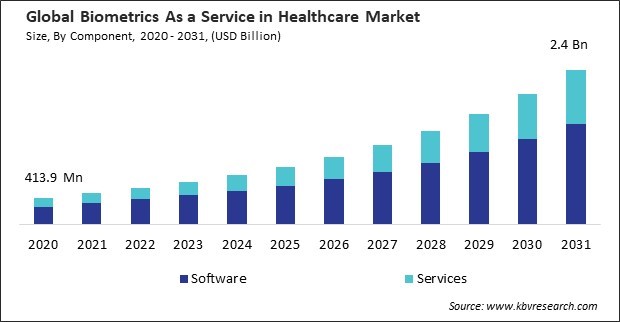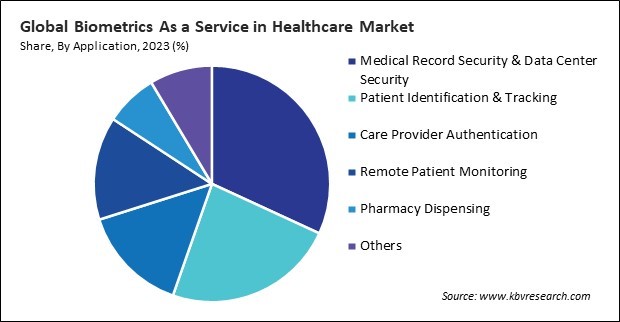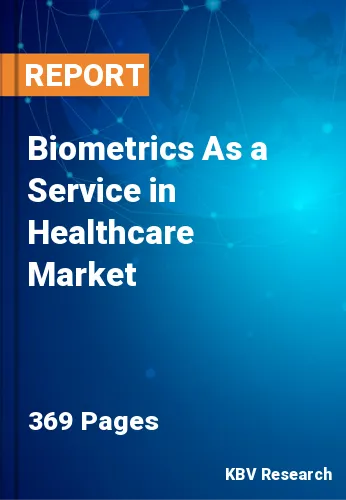“Global Biometrics As a Service in Healthcare Market to reach a market value of USD 2.4 Billion by 2031 growing at a CAGR of 17.5%”
The Global Biometrics As a Service in Healthcare Market size is expected to reach $2.4 billion by 2031, rising at a market growth of 17.5% CAGR during the forecast period.
By capturing biometric data at the point of care, healthcare organizations can expedite patient check-in, reduce wait times, and improve the efficiency of clinical operations, enhancing patient satisfaction and care delivery. Thus, the patient identification & tracking segment recorded 23.5% revenue share in the market 2023. Biometric authentication solutions enhance medication safety and administration by accurately identifying patients and matching them with prescribed medications.

The pandemic increased reliance on remote patient monitoring and home-based care options to reduce the burden on healthcare facilities while minimizing the danger of virus exposure. Biometric authentication enables secure access to remote monitoring systems and medical devices, facilitating the delivery of virtual care services to patients in their homes while ensuring data privacy and security. Thus, the COVID-19 pandemic had a positive effect on the market.
Biometric authentication streamlines access to patient health records within HIE networks, improving interoperability and workflow efficiency across healthcare systems. Healthcare professionals can more effectively coordinate patient care and make decisions by having secure access to patient data from various sources without needing separate login credentials.
Additionally, Healthcare providers can monitor patients' biometric data and health conditions remotely with mHealth systems that frequently have remote patient monitoring features. Biometric authentication guarantees the security of access to these monitoring systems. Thus, because of the rise of mobile health (mHealth) solutions, the market is anticipated to increase significantly.
However, Interoperability challenges may result in complex data exchange workflows and manual data entry processes, increasing the risk of errors, inconsistencies, and data inaccuracies. Healthcare providers may struggle to navigate disparate systems, interfaces, and data formats when accessing patient information or performing biometric authentication tasks, leading to workflow inefficiencies and user frustration. Therefore, interoperability challenges in flow meters are a significant challenge that hampers the growth of market.
By component, the market is categorized into software and services. In 2023, the software segment held 68.3% revenue share in the market.
On the basis of solution type, the market is divided into fingerprint scanning, facial recognition, iris recognition, voice recognition, palm & vein recognition, and others. The facial recognition segment garnered 14.5% revenue share in the market in 2023.
Based on modality, the market is bifurcated into unimodal and multimodal. In 2023, the multimodal segment witnessed 61.7% revenue share in the market.
By application, the market is classified into patient identification & tracking, medical record security & data center security, care provider authentication, remote patient monitoring, pharmacy dispensing, and others. The care provider authentication segment procured 14.5% growth rate in the market in 2023.

Based on end user, the market is segmented into hospitals & clinics, long term care centers & home care settings, ambulatory surgical centers, and others. The long-term care centers & home care settings segment covered 23.6% revenue share in the market in 2023.
Free Valuable Insights: Global Biometrics As a Service in Healthcare Market size to reach USD 2.4 Billion by 2031
Region-wise, the market is analysed across North America, Europe, Asia Pacific, and LAMEA. In 2023, the Asia Pacific region acquired 27.5% revenue share in the market. Rising healthcare spending and investments in healthcare infrastructure across Asia Pacific countries.
| Report Attribute | Details |
|---|---|
| Market size value in 2023 | USD 675.9 Million |
| Market size forecast in 2031 | USD 2.4 Billion |
| Base Year | 2023 |
| Historical Period | 2020 to 2022 |
| Forecast Period | 2024 to 2031 |
| Revenue Growth Rate | CAGR of 17.5% from 2024 to 2031 |
| Number of Pages | 369 |
| Number of Tables | 580 |
| Report coverage | Market Trends, Revenue Estimation and Forecast, Segmentation Analysis, Regional and Country Breakdown, Porter’s 5 Forces Analysis, Company Profiling, Companies Strategic Developments, SWOT Analysis, Winning Imperatives |
| Segments covered | Component, Solution Type, Modality, Application, End User, Region |
| Country scope |
|
| Companies Included | Hitachi, Ltd. (Hitachi Astemo, Ltd.), Fujitsu Limited, NICE Ltd., Thales Group S.A., HID Global Corporation (Assa Abloy AB), NEC Corporation, BIO-key International, Inc., IDEMIA SAS (Advent International, Inc.), Cognitec Systems GmbH, Suprema, Inc. |
By Component
By Solution Type
By Modality
By Application
By End User
By Geography
This Market size is expected to reach $2.4 billion by 2031.
Integration with health information exchange (HIE) networks are driving the Market in coming years, however, Rising privacy concerns of BaaS in healthcare restraints the growth of the Market.
Hitachi, Ltd. (Hitachi Astemo, Ltd.), Fujitsu Limited, NICE Ltd., Thales Group S.A., HID Global Corporation (Assa Abloy AB), NEC Corporation, BIO-key International, Inc., IDEMIA SAS (Advent International, Inc.), Cognitec Systems GmbH, Suprema, Inc.
The expected CAGR of this Market is 17.5% from 2024 to 2031.
The Medical Record Security & Data Center Security segment is leading the Market by Application in 2023, achieving a market value of $688.9 million by 2031.
The North America region dominated the Market by Region in 2023, and would continue to be a dominant market till 2031; thereby, achieving a market value of $870.6 million by 2031.
Our team of dedicated experts can provide you with attractive expansion opportunities for your business.

 Drivers
Drivers
 Restraints
Restraints
 Opportunities
Opportunities
 Challenges
Challenges
